Using Data to Improve Learning
VerifiedAdded on 2023/04/06
|18
|3860
|494
AI Summary
This study explores the use of data to improve learning in primary schools, specifically focusing on numeracy and grammar skills. It compares the performance of Aberdeen Public School and Bald Face Public School using quantitative and qualitative research methods.
Contribute Materials
Your contribution can guide someone’s learning journey. Share your
documents today.
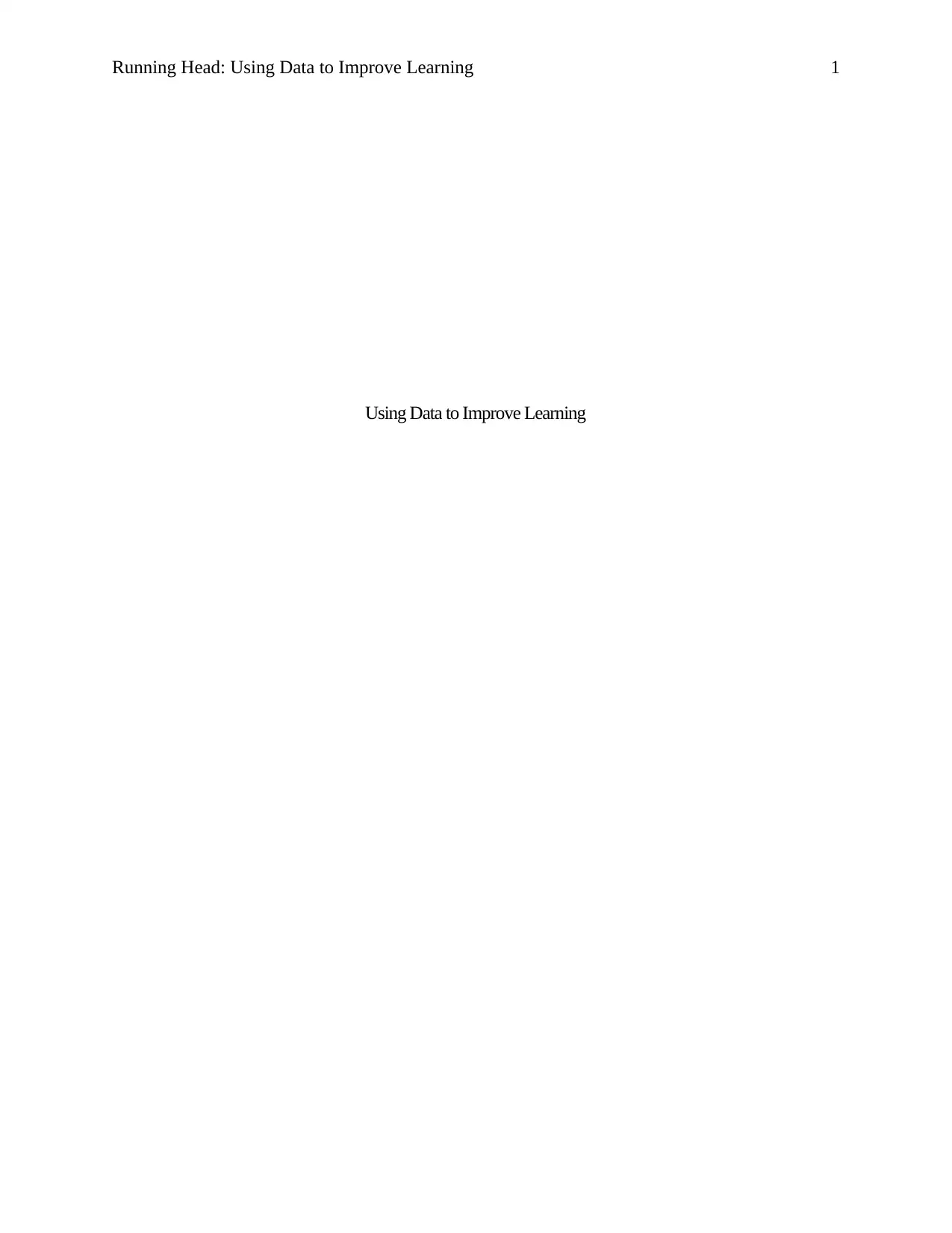
Running Head: Using Data to Improve Learning 1
Using Data to Improve Learning
Using Data to Improve Learning
Secure Best Marks with AI Grader
Need help grading? Try our AI Grader for instant feedback on your assignments.
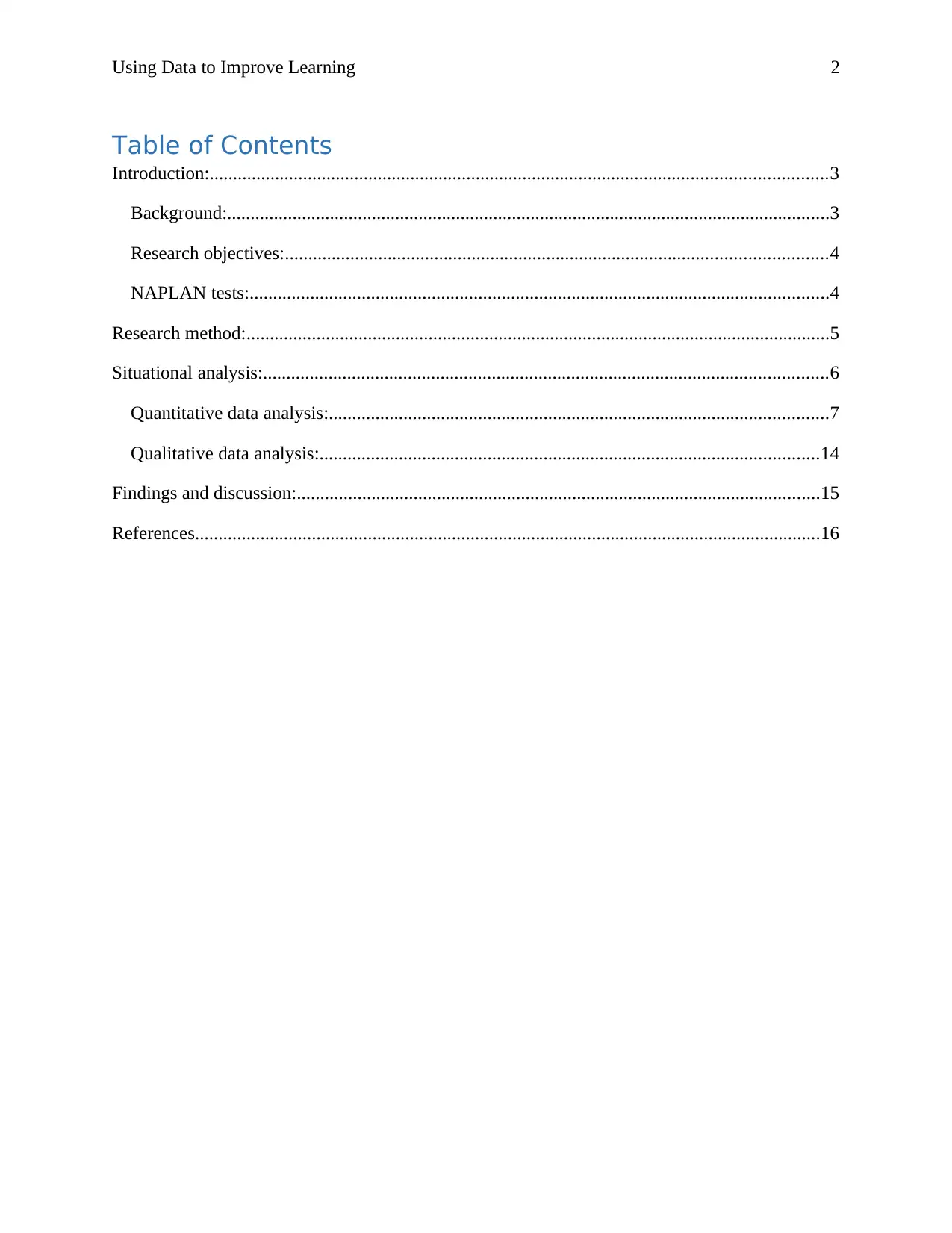
Using Data to Improve Learning 2
Table of Contents
Introduction:....................................................................................................................................3
Background:.................................................................................................................................3
Research objectives:....................................................................................................................4
NAPLAN tests:............................................................................................................................4
Research method:.............................................................................................................................5
Situational analysis:.........................................................................................................................6
Quantitative data analysis:...........................................................................................................7
Qualitative data analysis:...........................................................................................................14
Findings and discussion:................................................................................................................15
References......................................................................................................................................16
Table of Contents
Introduction:....................................................................................................................................3
Background:.................................................................................................................................3
Research objectives:....................................................................................................................4
NAPLAN tests:............................................................................................................................4
Research method:.............................................................................................................................5
Situational analysis:.........................................................................................................................6
Quantitative data analysis:...........................................................................................................7
Qualitative data analysis:...........................................................................................................14
Findings and discussion:................................................................................................................15
References......................................................................................................................................16
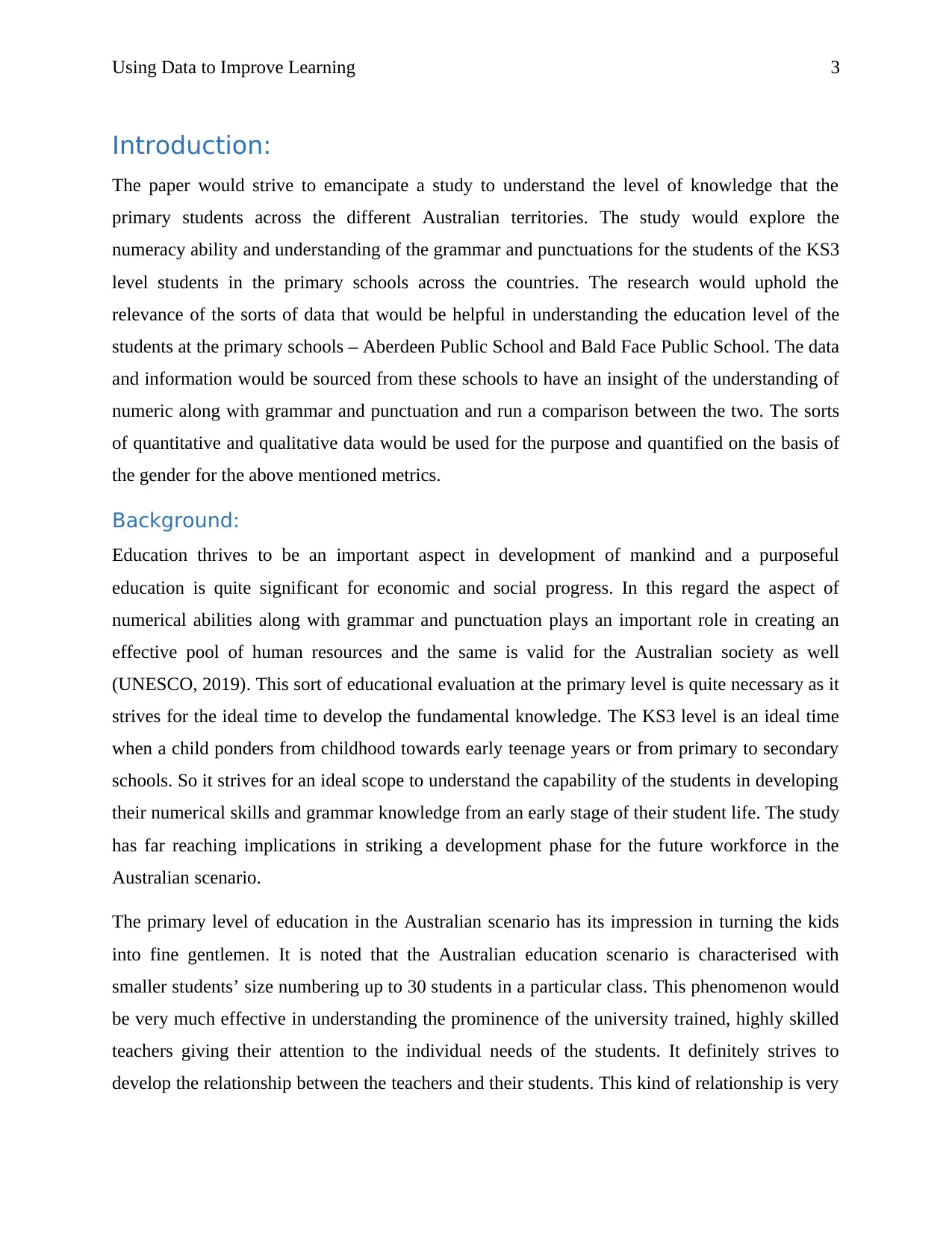
Using Data to Improve Learning 3
Introduction:
The paper would strive to emancipate a study to understand the level of knowledge that the
primary students across the different Australian territories. The study would explore the
numeracy ability and understanding of the grammar and punctuations for the students of the KS3
level students in the primary schools across the countries. The research would uphold the
relevance of the sorts of data that would be helpful in understanding the education level of the
students at the primary schools – Aberdeen Public School and Bald Face Public School. The data
and information would be sourced from these schools to have an insight of the understanding of
numeric along with grammar and punctuation and run a comparison between the two. The sorts
of quantitative and qualitative data would be used for the purpose and quantified on the basis of
the gender for the above mentioned metrics.
Background:
Education thrives to be an important aspect in development of mankind and a purposeful
education is quite significant for economic and social progress. In this regard the aspect of
numerical abilities along with grammar and punctuation plays an important role in creating an
effective pool of human resources and the same is valid for the Australian society as well
(UNESCO, 2019). This sort of educational evaluation at the primary level is quite necessary as it
strives for the ideal time to develop the fundamental knowledge. The KS3 level is an ideal time
when a child ponders from childhood towards early teenage years or from primary to secondary
schools. So it strives for an ideal scope to understand the capability of the students in developing
their numerical skills and grammar knowledge from an early stage of their student life. The study
has far reaching implications in striking a development phase for the future workforce in the
Australian scenario.
The primary level of education in the Australian scenario has its impression in turning the kids
into fine gentlemen. It is noted that the Australian education scenario is characterised with
smaller students’ size numbering up to 30 students in a particular class. This phenomenon would
be very much effective in understanding the prominence of the university trained, highly skilled
teachers giving their attention to the individual needs of the students. It definitely strives to
develop the relationship between the teachers and their students. This kind of relationship is very
Introduction:
The paper would strive to emancipate a study to understand the level of knowledge that the
primary students across the different Australian territories. The study would explore the
numeracy ability and understanding of the grammar and punctuations for the students of the KS3
level students in the primary schools across the countries. The research would uphold the
relevance of the sorts of data that would be helpful in understanding the education level of the
students at the primary schools – Aberdeen Public School and Bald Face Public School. The data
and information would be sourced from these schools to have an insight of the understanding of
numeric along with grammar and punctuation and run a comparison between the two. The sorts
of quantitative and qualitative data would be used for the purpose and quantified on the basis of
the gender for the above mentioned metrics.
Background:
Education thrives to be an important aspect in development of mankind and a purposeful
education is quite significant for economic and social progress. In this regard the aspect of
numerical abilities along with grammar and punctuation plays an important role in creating an
effective pool of human resources and the same is valid for the Australian society as well
(UNESCO, 2019). This sort of educational evaluation at the primary level is quite necessary as it
strives for the ideal time to develop the fundamental knowledge. The KS3 level is an ideal time
when a child ponders from childhood towards early teenage years or from primary to secondary
schools. So it strives for an ideal scope to understand the capability of the students in developing
their numerical skills and grammar knowledge from an early stage of their student life. The study
has far reaching implications in striking a development phase for the future workforce in the
Australian scenario.
The primary level of education in the Australian scenario has its impression in turning the kids
into fine gentlemen. It is noted that the Australian education scenario is characterised with
smaller students’ size numbering up to 30 students in a particular class. This phenomenon would
be very much effective in understanding the prominence of the university trained, highly skilled
teachers giving their attention to the individual needs of the students. It definitely strives to
develop the relationship between the teachers and their students. This kind of relationship is very
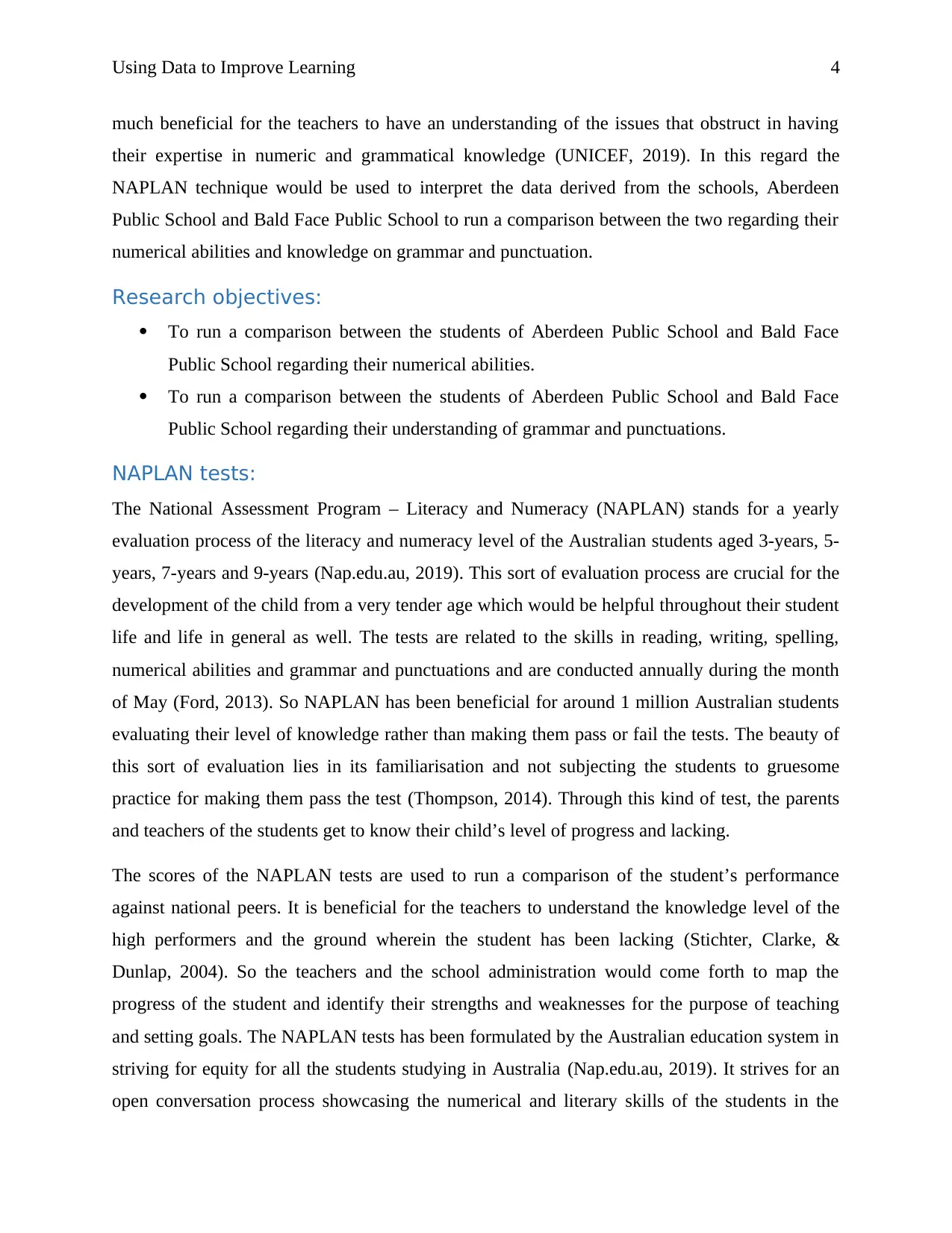
Using Data to Improve Learning 4
much beneficial for the teachers to have an understanding of the issues that obstruct in having
their expertise in numeric and grammatical knowledge (UNICEF, 2019). In this regard the
NAPLAN technique would be used to interpret the data derived from the schools, Aberdeen
Public School and Bald Face Public School to run a comparison between the two regarding their
numerical abilities and knowledge on grammar and punctuation.
Research objectives:
To run a comparison between the students of Aberdeen Public School and Bald Face
Public School regarding their numerical abilities.
To run a comparison between the students of Aberdeen Public School and Bald Face
Public School regarding their understanding of grammar and punctuations.
NAPLAN tests:
The National Assessment Program – Literacy and Numeracy (NAPLAN) stands for a yearly
evaluation process of the literacy and numeracy level of the Australian students aged 3-years, 5-
years, 7-years and 9-years (Nap.edu.au, 2019). This sort of evaluation process are crucial for the
development of the child from a very tender age which would be helpful throughout their student
life and life in general as well. The tests are related to the skills in reading, writing, spelling,
numerical abilities and grammar and punctuations and are conducted annually during the month
of May (Ford, 2013). So NAPLAN has been beneficial for around 1 million Australian students
evaluating their level of knowledge rather than making them pass or fail the tests. The beauty of
this sort of evaluation lies in its familiarisation and not subjecting the students to gruesome
practice for making them pass the test (Thompson, 2014). Through this kind of test, the parents
and teachers of the students get to know their child’s level of progress and lacking.
The scores of the NAPLAN tests are used to run a comparison of the student’s performance
against national peers. It is beneficial for the teachers to understand the knowledge level of the
high performers and the ground wherein the student has been lacking (Stichter, Clarke, &
Dunlap, 2004). So the teachers and the school administration would come forth to map the
progress of the student and identify their strengths and weaknesses for the purpose of teaching
and setting goals. The NAPLAN tests has been formulated by the Australian education system in
striving for equity for all the students studying in Australia (Nap.edu.au, 2019). It strives for an
open conversation process showcasing the numerical and literary skills of the students in the
much beneficial for the teachers to have an understanding of the issues that obstruct in having
their expertise in numeric and grammatical knowledge (UNICEF, 2019). In this regard the
NAPLAN technique would be used to interpret the data derived from the schools, Aberdeen
Public School and Bald Face Public School to run a comparison between the two regarding their
numerical abilities and knowledge on grammar and punctuation.
Research objectives:
To run a comparison between the students of Aberdeen Public School and Bald Face
Public School regarding their numerical abilities.
To run a comparison between the students of Aberdeen Public School and Bald Face
Public School regarding their understanding of grammar and punctuations.
NAPLAN tests:
The National Assessment Program – Literacy and Numeracy (NAPLAN) stands for a yearly
evaluation process of the literacy and numeracy level of the Australian students aged 3-years, 5-
years, 7-years and 9-years (Nap.edu.au, 2019). This sort of evaluation process are crucial for the
development of the child from a very tender age which would be helpful throughout their student
life and life in general as well. The tests are related to the skills in reading, writing, spelling,
numerical abilities and grammar and punctuations and are conducted annually during the month
of May (Ford, 2013). So NAPLAN has been beneficial for around 1 million Australian students
evaluating their level of knowledge rather than making them pass or fail the tests. The beauty of
this sort of evaluation lies in its familiarisation and not subjecting the students to gruesome
practice for making them pass the test (Thompson, 2014). Through this kind of test, the parents
and teachers of the students get to know their child’s level of progress and lacking.
The scores of the NAPLAN tests are used to run a comparison of the student’s performance
against national peers. It is beneficial for the teachers to understand the knowledge level of the
high performers and the ground wherein the student has been lacking (Stichter, Clarke, &
Dunlap, 2004). So the teachers and the school administration would come forth to map the
progress of the student and identify their strengths and weaknesses for the purpose of teaching
and setting goals. The NAPLAN tests has been formulated by the Australian education system in
striving for equity for all the students studying in Australia (Nap.edu.au, 2019). It strives for an
open conversation process showcasing the numerical and literary skills of the students in the
Secure Best Marks with AI Grader
Need help grading? Try our AI Grader for instant feedback on your assignments.
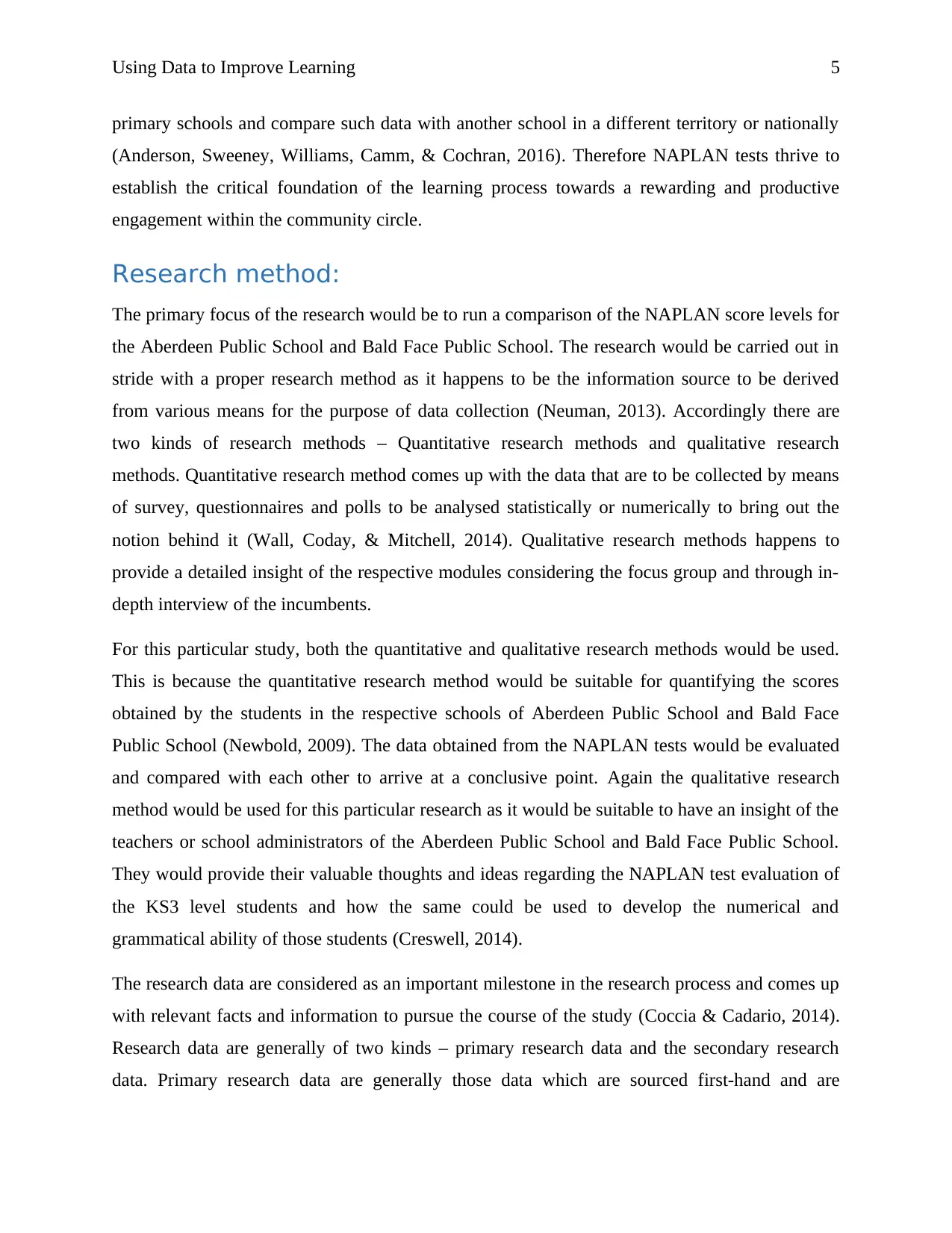
Using Data to Improve Learning 5
primary schools and compare such data with another school in a different territory or nationally
(Anderson, Sweeney, Williams, Camm, & Cochran, 2016). Therefore NAPLAN tests thrive to
establish the critical foundation of the learning process towards a rewarding and productive
engagement within the community circle.
Research method:
The primary focus of the research would be to run a comparison of the NAPLAN score levels for
the Aberdeen Public School and Bald Face Public School. The research would be carried out in
stride with a proper research method as it happens to be the information source to be derived
from various means for the purpose of data collection (Neuman, 2013). Accordingly there are
two kinds of research methods – Quantitative research methods and qualitative research
methods. Quantitative research method comes up with the data that are to be collected by means
of survey, questionnaires and polls to be analysed statistically or numerically to bring out the
notion behind it (Wall, Coday, & Mitchell, 2014). Qualitative research methods happens to
provide a detailed insight of the respective modules considering the focus group and through in-
depth interview of the incumbents.
For this particular study, both the quantitative and qualitative research methods would be used.
This is because the quantitative research method would be suitable for quantifying the scores
obtained by the students in the respective schools of Aberdeen Public School and Bald Face
Public School (Newbold, 2009). The data obtained from the NAPLAN tests would be evaluated
and compared with each other to arrive at a conclusive point. Again the qualitative research
method would be used for this particular research as it would be suitable to have an insight of the
teachers or school administrators of the Aberdeen Public School and Bald Face Public School.
They would provide their valuable thoughts and ideas regarding the NAPLAN test evaluation of
the KS3 level students and how the same could be used to develop the numerical and
grammatical ability of those students (Creswell, 2014).
The research data are considered as an important milestone in the research process and comes up
with relevant facts and information to pursue the course of the study (Coccia & Cadario, 2014).
Research data are generally of two kinds – primary research data and the secondary research
data. Primary research data are generally those data which are sourced first-hand and are
primary schools and compare such data with another school in a different territory or nationally
(Anderson, Sweeney, Williams, Camm, & Cochran, 2016). Therefore NAPLAN tests thrive to
establish the critical foundation of the learning process towards a rewarding and productive
engagement within the community circle.
Research method:
The primary focus of the research would be to run a comparison of the NAPLAN score levels for
the Aberdeen Public School and Bald Face Public School. The research would be carried out in
stride with a proper research method as it happens to be the information source to be derived
from various means for the purpose of data collection (Neuman, 2013). Accordingly there are
two kinds of research methods – Quantitative research methods and qualitative research
methods. Quantitative research method comes up with the data that are to be collected by means
of survey, questionnaires and polls to be analysed statistically or numerically to bring out the
notion behind it (Wall, Coday, & Mitchell, 2014). Qualitative research methods happens to
provide a detailed insight of the respective modules considering the focus group and through in-
depth interview of the incumbents.
For this particular study, both the quantitative and qualitative research methods would be used.
This is because the quantitative research method would be suitable for quantifying the scores
obtained by the students in the respective schools of Aberdeen Public School and Bald Face
Public School (Newbold, 2009). The data obtained from the NAPLAN tests would be evaluated
and compared with each other to arrive at a conclusive point. Again the qualitative research
method would be used for this particular research as it would be suitable to have an insight of the
teachers or school administrators of the Aberdeen Public School and Bald Face Public School.
They would provide their valuable thoughts and ideas regarding the NAPLAN test evaluation of
the KS3 level students and how the same could be used to develop the numerical and
grammatical ability of those students (Creswell, 2014).
The research data are considered as an important milestone in the research process and comes up
with relevant facts and information to pursue the course of the study (Coccia & Cadario, 2014).
Research data are generally of two kinds – primary research data and the secondary research
data. Primary research data are generally those data which are sourced first-hand and are
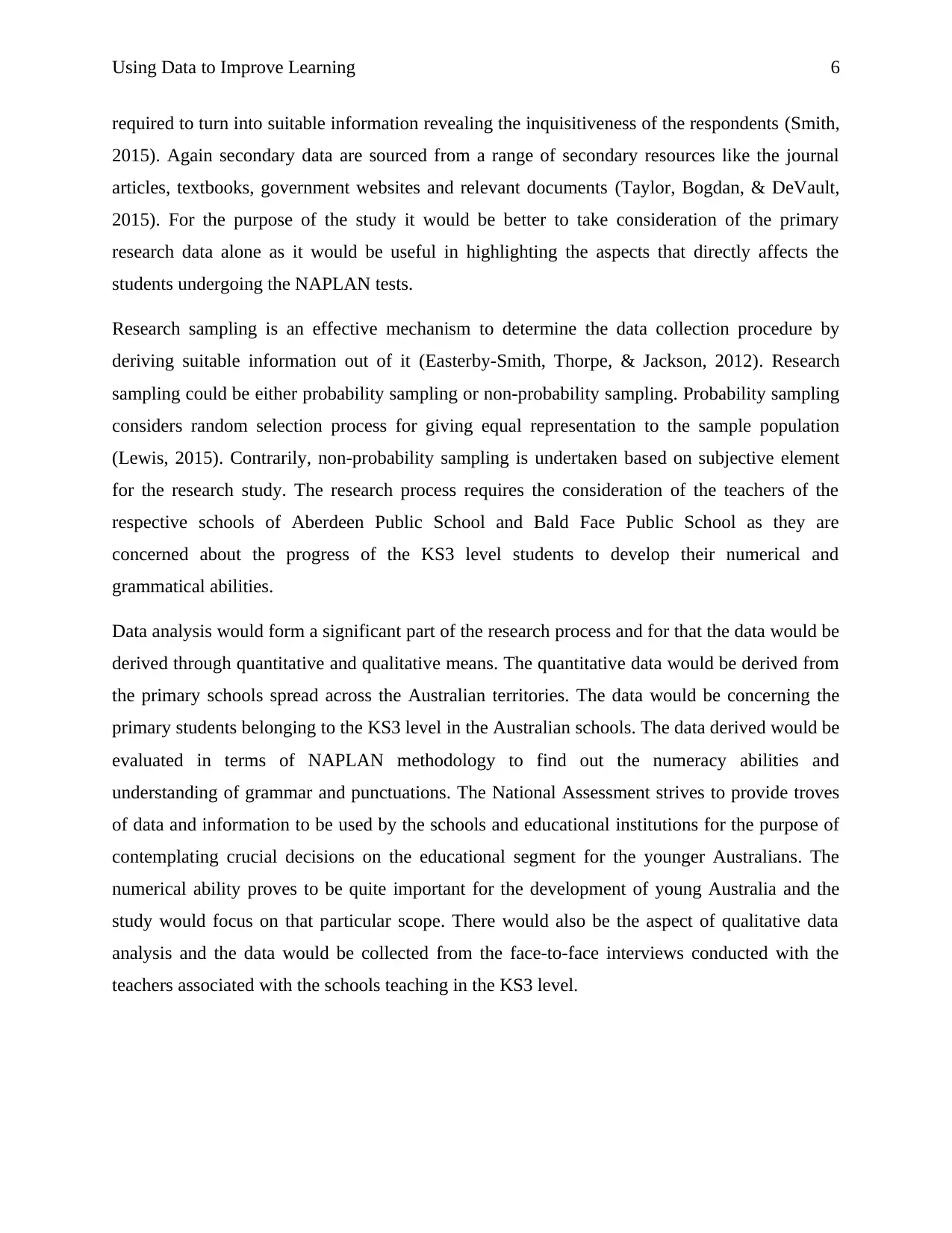
Using Data to Improve Learning 6
required to turn into suitable information revealing the inquisitiveness of the respondents (Smith,
2015). Again secondary data are sourced from a range of secondary resources like the journal
articles, textbooks, government websites and relevant documents (Taylor, Bogdan, & DeVault,
2015). For the purpose of the study it would be better to take consideration of the primary
research data alone as it would be useful in highlighting the aspects that directly affects the
students undergoing the NAPLAN tests.
Research sampling is an effective mechanism to determine the data collection procedure by
deriving suitable information out of it (Easterby-Smith, Thorpe, & Jackson, 2012). Research
sampling could be either probability sampling or non-probability sampling. Probability sampling
considers random selection process for giving equal representation to the sample population
(Lewis, 2015). Contrarily, non-probability sampling is undertaken based on subjective element
for the research study. The research process requires the consideration of the teachers of the
respective schools of Aberdeen Public School and Bald Face Public School as they are
concerned about the progress of the KS3 level students to develop their numerical and
grammatical abilities.
Data analysis would form a significant part of the research process and for that the data would be
derived through quantitative and qualitative means. The quantitative data would be derived from
the primary schools spread across the Australian territories. The data would be concerning the
primary students belonging to the KS3 level in the Australian schools. The data derived would be
evaluated in terms of NAPLAN methodology to find out the numeracy abilities and
understanding of grammar and punctuations. The National Assessment strives to provide troves
of data and information to be used by the schools and educational institutions for the purpose of
contemplating crucial decisions on the educational segment for the younger Australians. The
numerical ability proves to be quite important for the development of young Australia and the
study would focus on that particular scope. There would also be the aspect of qualitative data
analysis and the data would be collected from the face-to-face interviews conducted with the
teachers associated with the schools teaching in the KS3 level.
required to turn into suitable information revealing the inquisitiveness of the respondents (Smith,
2015). Again secondary data are sourced from a range of secondary resources like the journal
articles, textbooks, government websites and relevant documents (Taylor, Bogdan, & DeVault,
2015). For the purpose of the study it would be better to take consideration of the primary
research data alone as it would be useful in highlighting the aspects that directly affects the
students undergoing the NAPLAN tests.
Research sampling is an effective mechanism to determine the data collection procedure by
deriving suitable information out of it (Easterby-Smith, Thorpe, & Jackson, 2012). Research
sampling could be either probability sampling or non-probability sampling. Probability sampling
considers random selection process for giving equal representation to the sample population
(Lewis, 2015). Contrarily, non-probability sampling is undertaken based on subjective element
for the research study. The research process requires the consideration of the teachers of the
respective schools of Aberdeen Public School and Bald Face Public School as they are
concerned about the progress of the KS3 level students to develop their numerical and
grammatical abilities.
Data analysis would form a significant part of the research process and for that the data would be
derived through quantitative and qualitative means. The quantitative data would be derived from
the primary schools spread across the Australian territories. The data would be concerning the
primary students belonging to the KS3 level in the Australian schools. The data derived would be
evaluated in terms of NAPLAN methodology to find out the numeracy abilities and
understanding of grammar and punctuations. The National Assessment strives to provide troves
of data and information to be used by the schools and educational institutions for the purpose of
contemplating crucial decisions on the educational segment for the younger Australians. The
numerical ability proves to be quite important for the development of young Australia and the
study would focus on that particular scope. There would also be the aspect of qualitative data
analysis and the data would be collected from the face-to-face interviews conducted with the
teachers associated with the schools teaching in the KS3 level.

Using Data to Improve Learning 7
Situational analysis:
In this section the respective educational scenario of Aberdeen Public School and Bald Face
Public School would be presented individually and compared to have a suitable conclusion out of
it. It would point out certain generalised and definite aspects that would be suitable to find out
the level of progress of the students for the respective schools.
Quantitative data analysis:
Gender distribution –
Source: (Myschool.edu.au, 2019)
The above pie chart shows the gender distribution for Aberdeen public School located at
Aberdeen of the New South Wales territory. It shows that out of the total 227 students studying
there, girls are more in number – 115 while 112 pupils are boys. The girls outnumber the boys by
being 51% of the total population though the boys are quite close at 49%.
Situational analysis:
In this section the respective educational scenario of Aberdeen Public School and Bald Face
Public School would be presented individually and compared to have a suitable conclusion out of
it. It would point out certain generalised and definite aspects that would be suitable to find out
the level of progress of the students for the respective schools.
Quantitative data analysis:
Gender distribution –
Source: (Myschool.edu.au, 2019)
The above pie chart shows the gender distribution for Aberdeen public School located at
Aberdeen of the New South Wales territory. It shows that out of the total 227 students studying
there, girls are more in number – 115 while 112 pupils are boys. The girls outnumber the boys by
being 51% of the total population though the boys are quite close at 49%.
Paraphrase This Document
Need a fresh take? Get an instant paraphrase of this document with our AI Paraphraser
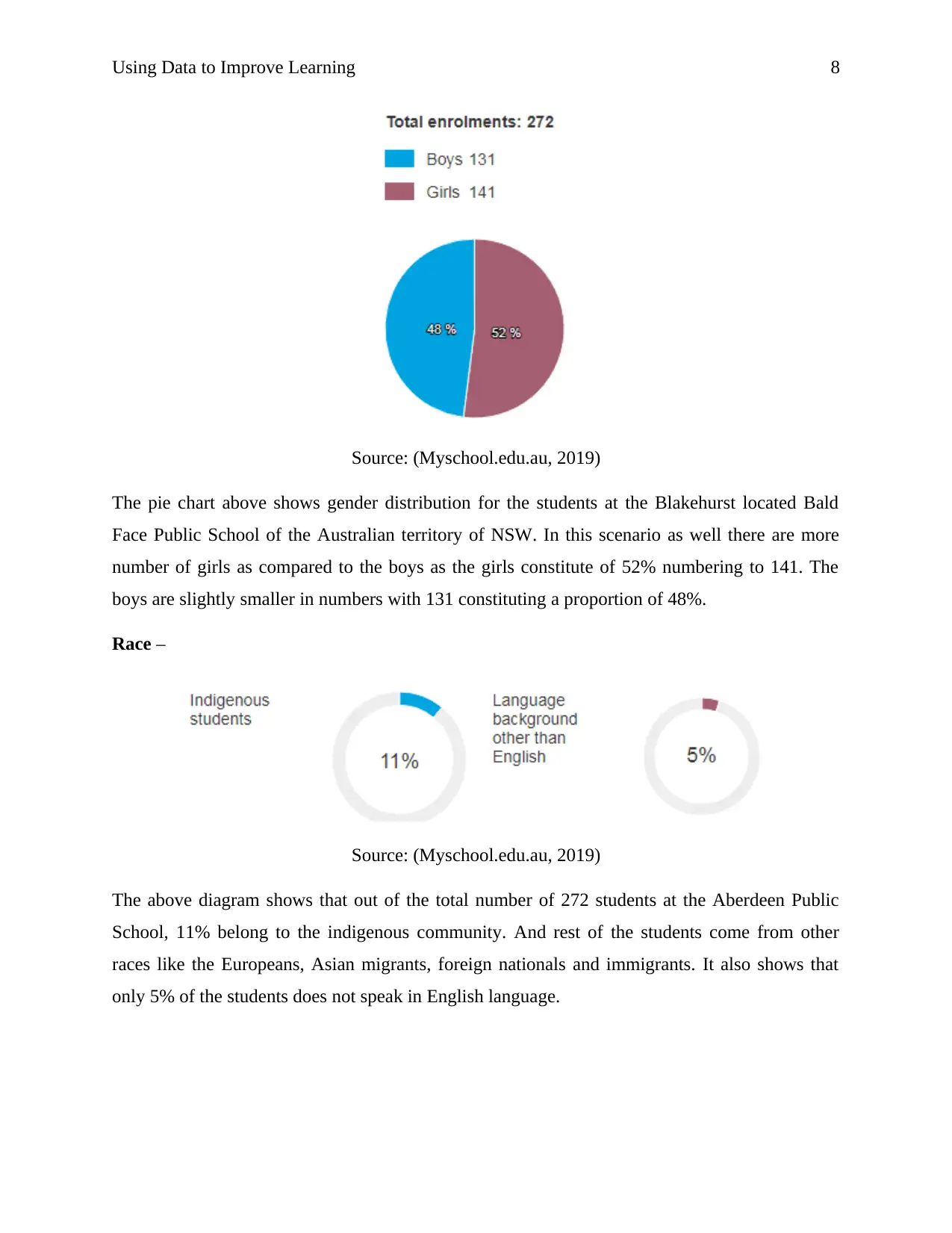
Using Data to Improve Learning 8
Source: (Myschool.edu.au, 2019)
The pie chart above shows gender distribution for the students at the Blakehurst located Bald
Face Public School of the Australian territory of NSW. In this scenario as well there are more
number of girls as compared to the boys as the girls constitute of 52% numbering to 141. The
boys are slightly smaller in numbers with 131 constituting a proportion of 48%.
Race –
Source: (Myschool.edu.au, 2019)
The above diagram shows that out of the total number of 272 students at the Aberdeen Public
School, 11% belong to the indigenous community. And rest of the students come from other
races like the Europeans, Asian migrants, foreign nationals and immigrants. It also shows that
only 5% of the students does not speak in English language.
Source: (Myschool.edu.au, 2019)
The pie chart above shows gender distribution for the students at the Blakehurst located Bald
Face Public School of the Australian territory of NSW. In this scenario as well there are more
number of girls as compared to the boys as the girls constitute of 52% numbering to 141. The
boys are slightly smaller in numbers with 131 constituting a proportion of 48%.
Race –
Source: (Myschool.edu.au, 2019)
The above diagram shows that out of the total number of 272 students at the Aberdeen Public
School, 11% belong to the indigenous community. And rest of the students come from other
races like the Europeans, Asian migrants, foreign nationals and immigrants. It also shows that
only 5% of the students does not speak in English language.
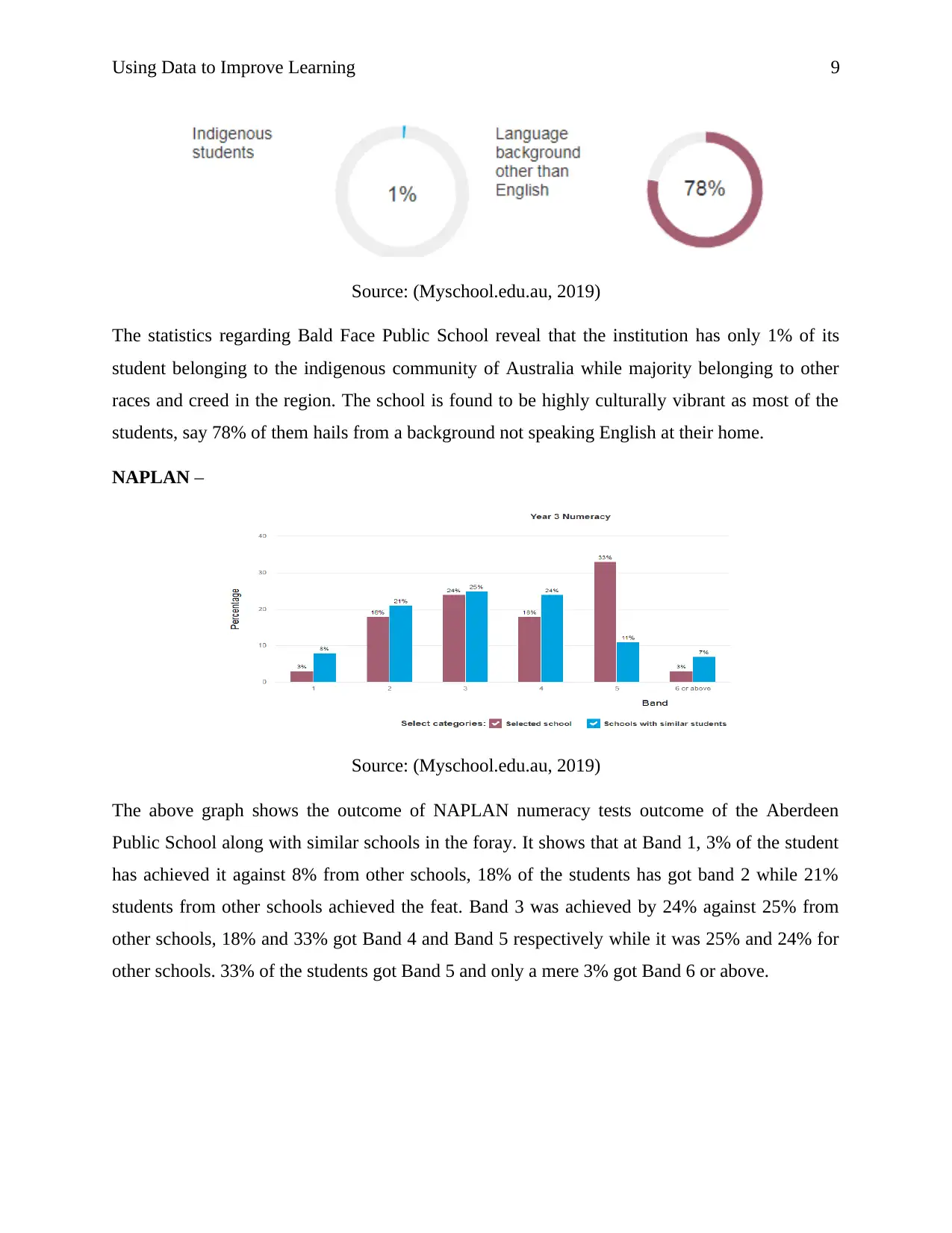
Using Data to Improve Learning 9
Source: (Myschool.edu.au, 2019)
The statistics regarding Bald Face Public School reveal that the institution has only 1% of its
student belonging to the indigenous community of Australia while majority belonging to other
races and creed in the region. The school is found to be highly culturally vibrant as most of the
students, say 78% of them hails from a background not speaking English at their home.
NAPLAN –
Source: (Myschool.edu.au, 2019)
The above graph shows the outcome of NAPLAN numeracy tests outcome of the Aberdeen
Public School along with similar schools in the foray. It shows that at Band 1, 3% of the student
has achieved it against 8% from other schools, 18% of the students has got band 2 while 21%
students from other schools achieved the feat. Band 3 was achieved by 24% against 25% from
other schools, 18% and 33% got Band 4 and Band 5 respectively while it was 25% and 24% for
other schools. 33% of the students got Band 5 and only a mere 3% got Band 6 or above.
Source: (Myschool.edu.au, 2019)
The statistics regarding Bald Face Public School reveal that the institution has only 1% of its
student belonging to the indigenous community of Australia while majority belonging to other
races and creed in the region. The school is found to be highly culturally vibrant as most of the
students, say 78% of them hails from a background not speaking English at their home.
NAPLAN –
Source: (Myschool.edu.au, 2019)
The above graph shows the outcome of NAPLAN numeracy tests outcome of the Aberdeen
Public School along with similar schools in the foray. It shows that at Band 1, 3% of the student
has achieved it against 8% from other schools, 18% of the students has got band 2 while 21%
students from other schools achieved the feat. Band 3 was achieved by 24% against 25% from
other schools, 18% and 33% got Band 4 and Band 5 respectively while it was 25% and 24% for
other schools. 33% of the students got Band 5 and only a mere 3% got Band 6 or above.
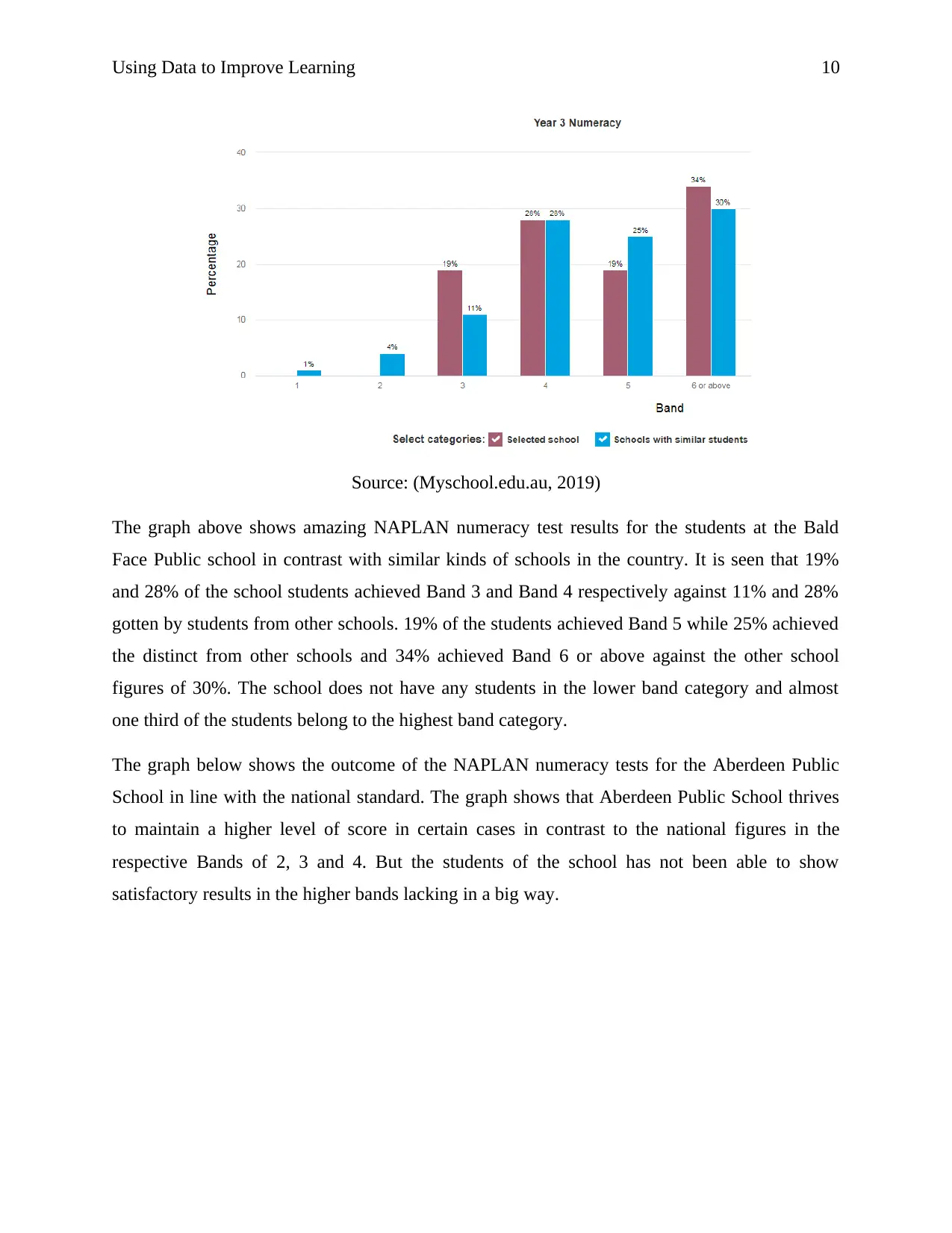
Using Data to Improve Learning 10
Source: (Myschool.edu.au, 2019)
The graph above shows amazing NAPLAN numeracy test results for the students at the Bald
Face Public school in contrast with similar kinds of schools in the country. It is seen that 19%
and 28% of the school students achieved Band 3 and Band 4 respectively against 11% and 28%
gotten by students from other schools. 19% of the students achieved Band 5 while 25% achieved
the distinct from other schools and 34% achieved Band 6 or above against the other school
figures of 30%. The school does not have any students in the lower band category and almost
one third of the students belong to the highest band category.
The graph below shows the outcome of the NAPLAN numeracy tests for the Aberdeen Public
School in line with the national standard. The graph shows that Aberdeen Public School thrives
to maintain a higher level of score in certain cases in contrast to the national figures in the
respective Bands of 2, 3 and 4. But the students of the school has not been able to show
satisfactory results in the higher bands lacking in a big way.
Source: (Myschool.edu.au, 2019)
The graph above shows amazing NAPLAN numeracy test results for the students at the Bald
Face Public school in contrast with similar kinds of schools in the country. It is seen that 19%
and 28% of the school students achieved Band 3 and Band 4 respectively against 11% and 28%
gotten by students from other schools. 19% of the students achieved Band 5 while 25% achieved
the distinct from other schools and 34% achieved Band 6 or above against the other school
figures of 30%. The school does not have any students in the lower band category and almost
one third of the students belong to the highest band category.
The graph below shows the outcome of the NAPLAN numeracy tests for the Aberdeen Public
School in line with the national standard. The graph shows that Aberdeen Public School thrives
to maintain a higher level of score in certain cases in contrast to the national figures in the
respective Bands of 2, 3 and 4. But the students of the school has not been able to show
satisfactory results in the higher bands lacking in a big way.
Secure Best Marks with AI Grader
Need help grading? Try our AI Grader for instant feedback on your assignments.
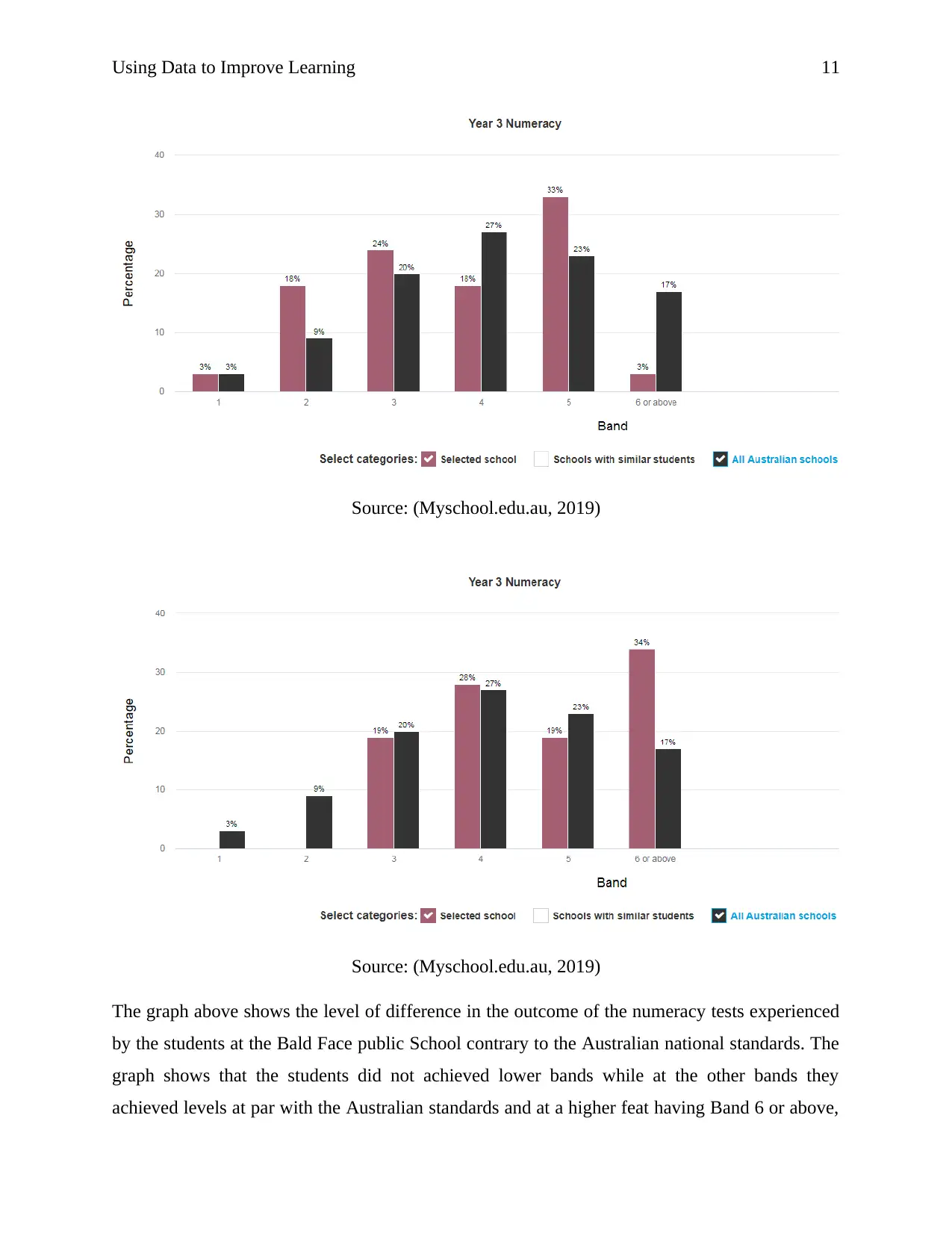
Using Data to Improve Learning 11
Source: (Myschool.edu.au, 2019)
Source: (Myschool.edu.au, 2019)
The graph above shows the level of difference in the outcome of the numeracy tests experienced
by the students at the Bald Face public School contrary to the Australian national standards. The
graph shows that the students did not achieved lower bands while at the other bands they
achieved levels at par with the Australian standards and at a higher feat having Band 6 or above,
Source: (Myschool.edu.au, 2019)
Source: (Myschool.edu.au, 2019)
The graph above shows the level of difference in the outcome of the numeracy tests experienced
by the students at the Bald Face public School contrary to the Australian national standards. The
graph shows that the students did not achieved lower bands while at the other bands they
achieved levels at par with the Australian standards and at a higher feat having Band 6 or above,
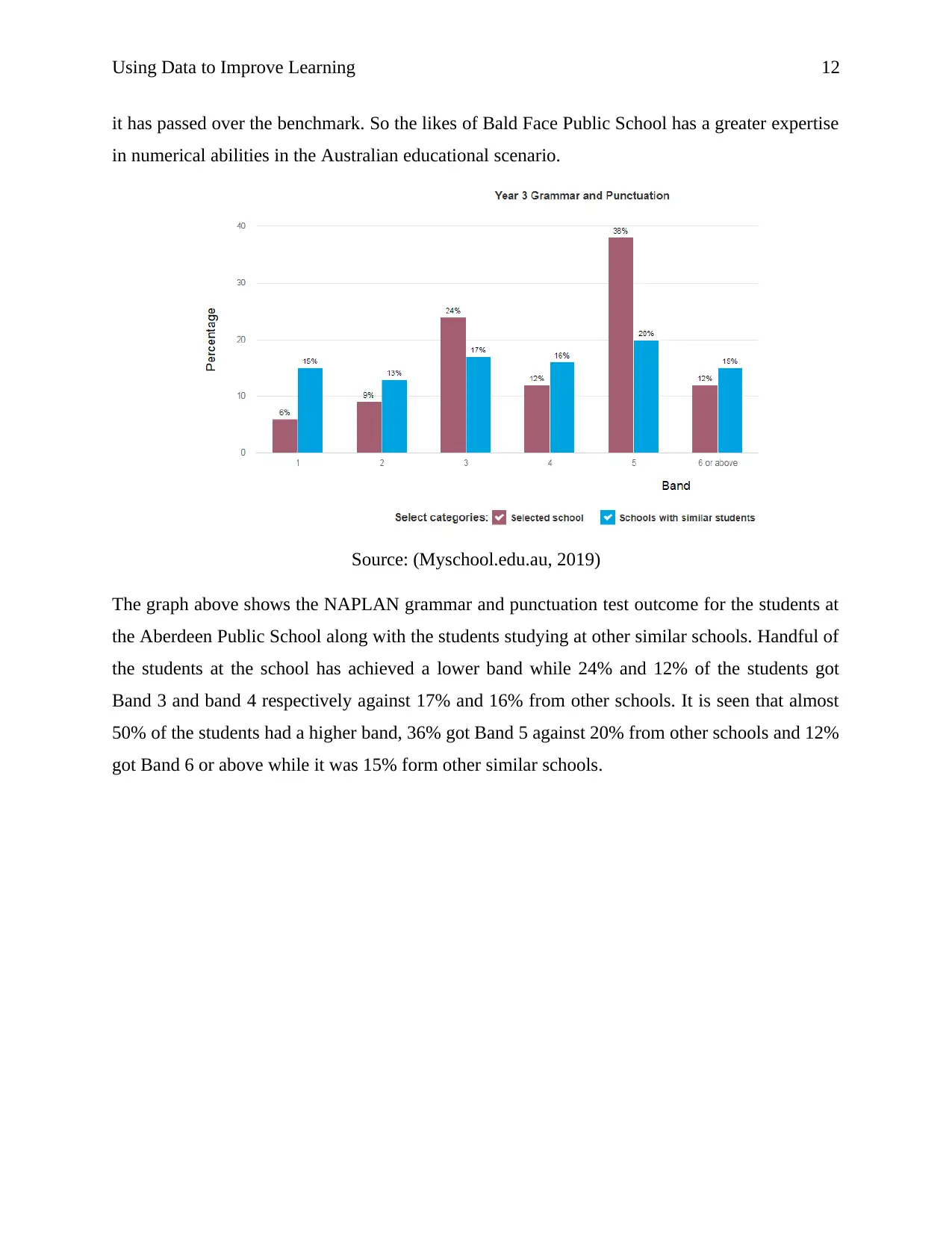
Using Data to Improve Learning 12
it has passed over the benchmark. So the likes of Bald Face Public School has a greater expertise
in numerical abilities in the Australian educational scenario.
Source: (Myschool.edu.au, 2019)
The graph above shows the NAPLAN grammar and punctuation test outcome for the students at
the Aberdeen Public School along with the students studying at other similar schools. Handful of
the students at the school has achieved a lower band while 24% and 12% of the students got
Band 3 and band 4 respectively against 17% and 16% from other schools. It is seen that almost
50% of the students had a higher band, 36% got Band 5 against 20% from other schools and 12%
got Band 6 or above while it was 15% form other similar schools.
it has passed over the benchmark. So the likes of Bald Face Public School has a greater expertise
in numerical abilities in the Australian educational scenario.
Source: (Myschool.edu.au, 2019)
The graph above shows the NAPLAN grammar and punctuation test outcome for the students at
the Aberdeen Public School along with the students studying at other similar schools. Handful of
the students at the school has achieved a lower band while 24% and 12% of the students got
Band 3 and band 4 respectively against 17% and 16% from other schools. It is seen that almost
50% of the students had a higher band, 36% got Band 5 against 20% from other schools and 12%
got Band 6 or above while it was 15% form other similar schools.
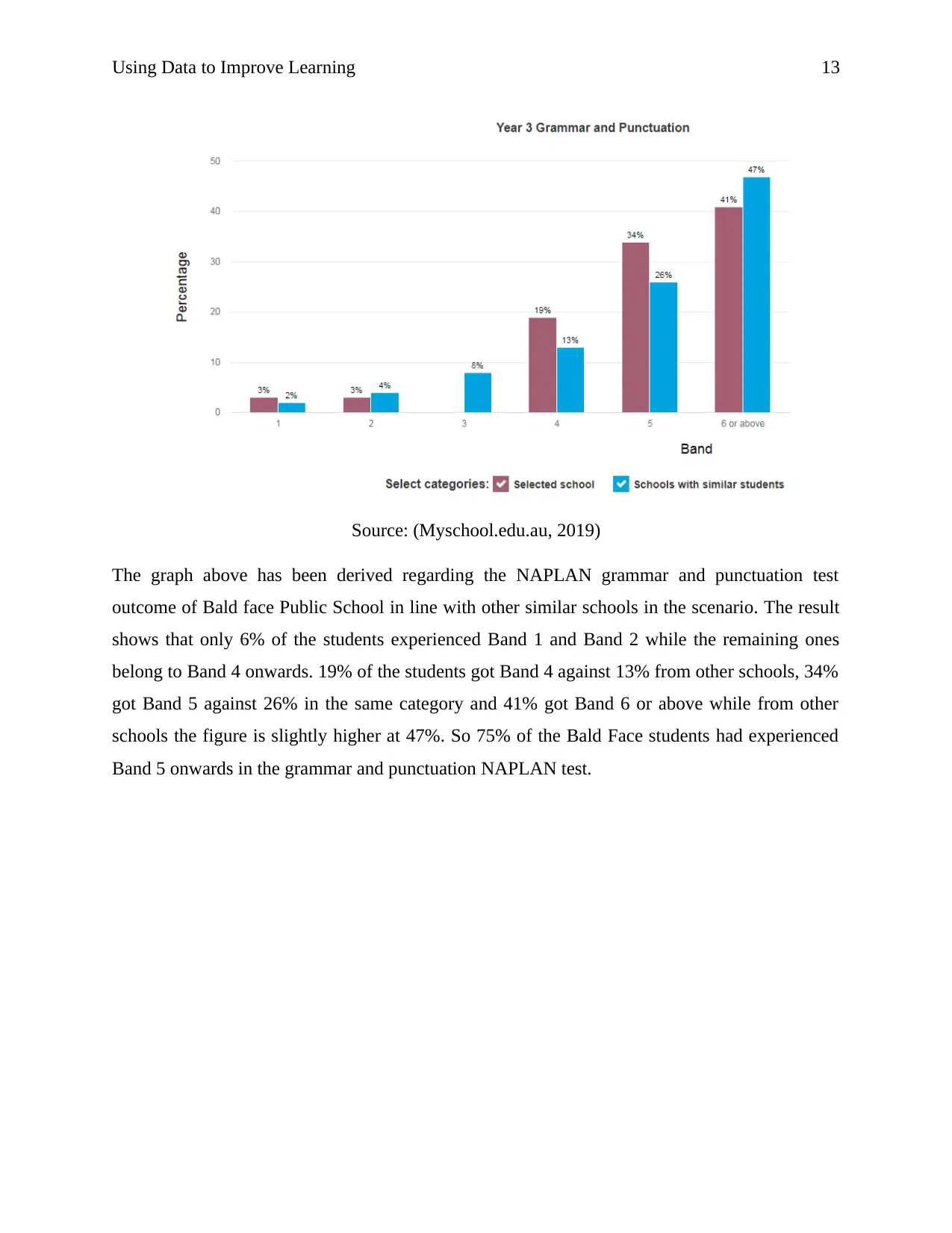
Using Data to Improve Learning 13
Source: (Myschool.edu.au, 2019)
The graph above has been derived regarding the NAPLAN grammar and punctuation test
outcome of Bald face Public School in line with other similar schools in the scenario. The result
shows that only 6% of the students experienced Band 1 and Band 2 while the remaining ones
belong to Band 4 onwards. 19% of the students got Band 4 against 13% from other schools, 34%
got Band 5 against 26% in the same category and 41% got Band 6 or above while from other
schools the figure is slightly higher at 47%. So 75% of the Bald Face students had experienced
Band 5 onwards in the grammar and punctuation NAPLAN test.
Source: (Myschool.edu.au, 2019)
The graph above has been derived regarding the NAPLAN grammar and punctuation test
outcome of Bald face Public School in line with other similar schools in the scenario. The result
shows that only 6% of the students experienced Band 1 and Band 2 while the remaining ones
belong to Band 4 onwards. 19% of the students got Band 4 against 13% from other schools, 34%
got Band 5 against 26% in the same category and 41% got Band 6 or above while from other
schools the figure is slightly higher at 47%. So 75% of the Bald Face students had experienced
Band 5 onwards in the grammar and punctuation NAPLAN test.
Paraphrase This Document
Need a fresh take? Get an instant paraphrase of this document with our AI Paraphraser
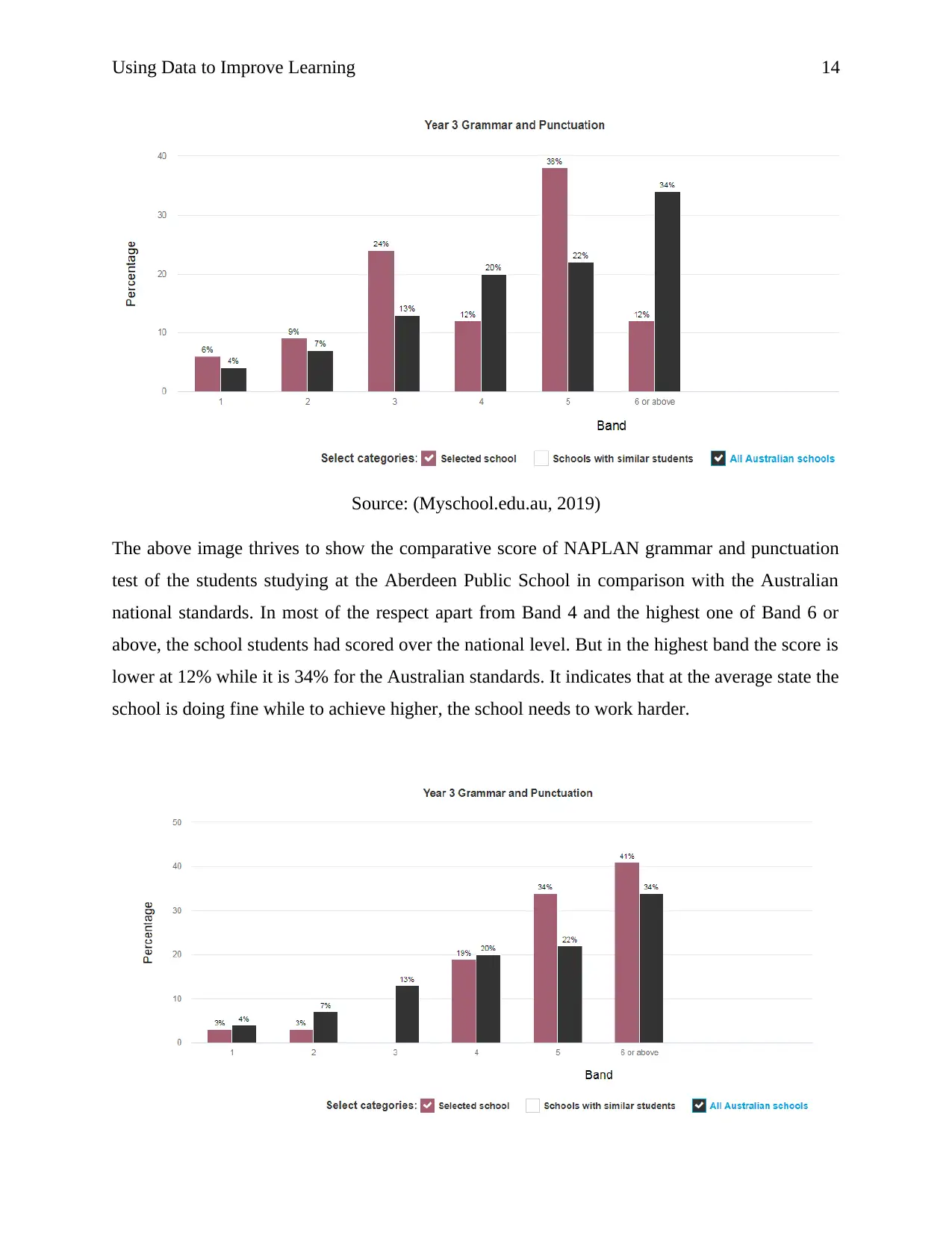
Using Data to Improve Learning 14
Source: (Myschool.edu.au, 2019)
The above image thrives to show the comparative score of NAPLAN grammar and punctuation
test of the students studying at the Aberdeen Public School in comparison with the Australian
national standards. In most of the respect apart from Band 4 and the highest one of Band 6 or
above, the school students had scored over the national level. But in the highest band the score is
lower at 12% while it is 34% for the Australian standards. It indicates that at the average state the
school is doing fine while to achieve higher, the school needs to work harder.
Source: (Myschool.edu.au, 2019)
The above image thrives to show the comparative score of NAPLAN grammar and punctuation
test of the students studying at the Aberdeen Public School in comparison with the Australian
national standards. In most of the respect apart from Band 4 and the highest one of Band 6 or
above, the school students had scored over the national level. But in the highest band the score is
lower at 12% while it is 34% for the Australian standards. It indicates that at the average state the
school is doing fine while to achieve higher, the school needs to work harder.
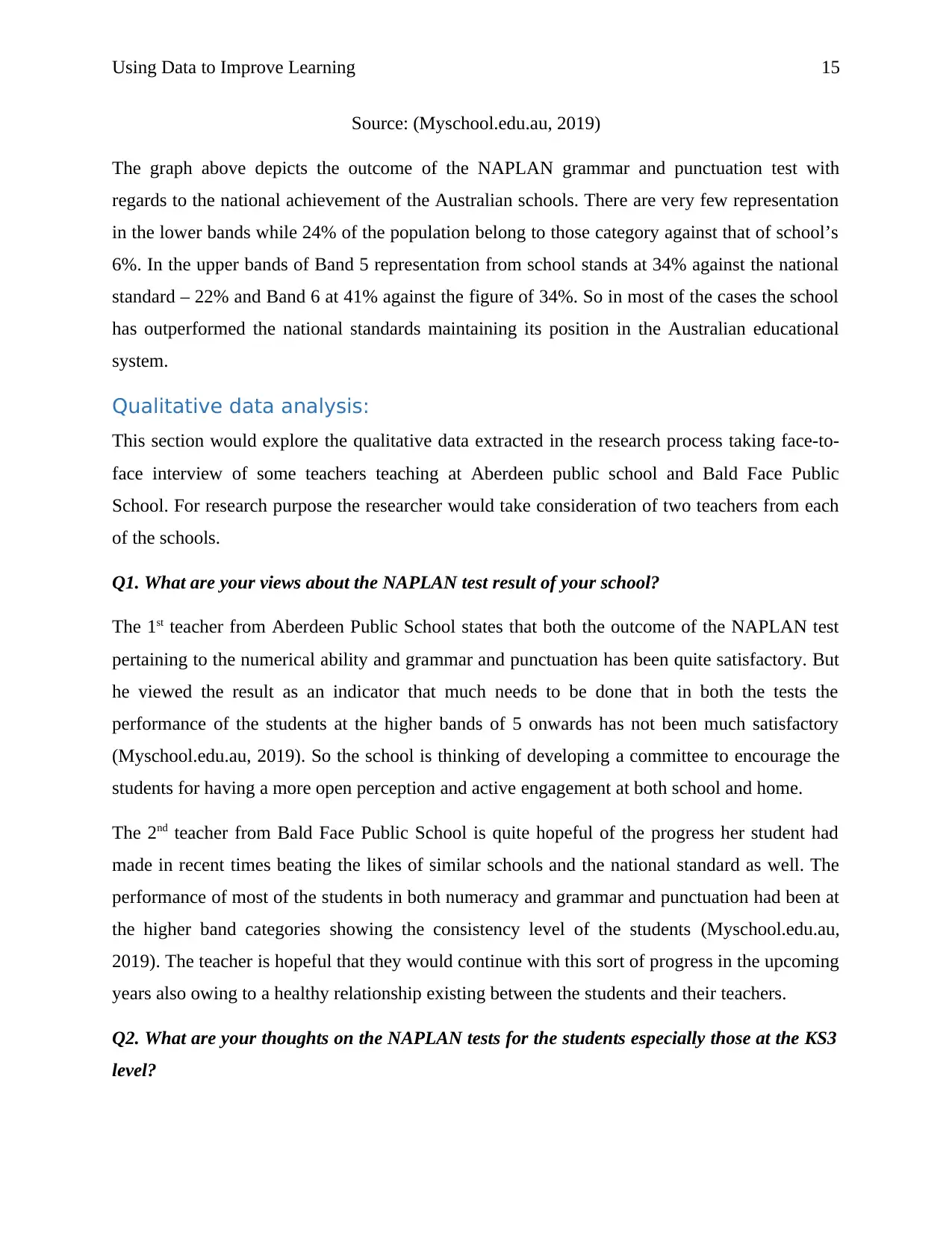
Using Data to Improve Learning 15
Source: (Myschool.edu.au, 2019)
The graph above depicts the outcome of the NAPLAN grammar and punctuation test with
regards to the national achievement of the Australian schools. There are very few representation
in the lower bands while 24% of the population belong to those category against that of school’s
6%. In the upper bands of Band 5 representation from school stands at 34% against the national
standard – 22% and Band 6 at 41% against the figure of 34%. So in most of the cases the school
has outperformed the national standards maintaining its position in the Australian educational
system.
Qualitative data analysis:
This section would explore the qualitative data extracted in the research process taking face-to-
face interview of some teachers teaching at Aberdeen public school and Bald Face Public
School. For research purpose the researcher would take consideration of two teachers from each
of the schools.
Q1. What are your views about the NAPLAN test result of your school?
The 1st teacher from Aberdeen Public School states that both the outcome of the NAPLAN test
pertaining to the numerical ability and grammar and punctuation has been quite satisfactory. But
he viewed the result as an indicator that much needs to be done that in both the tests the
performance of the students at the higher bands of 5 onwards has not been much satisfactory
(Myschool.edu.au, 2019). So the school is thinking of developing a committee to encourage the
students for having a more open perception and active engagement at both school and home.
The 2nd teacher from Bald Face Public School is quite hopeful of the progress her student had
made in recent times beating the likes of similar schools and the national standard as well. The
performance of most of the students in both numeracy and grammar and punctuation had been at
the higher band categories showing the consistency level of the students (Myschool.edu.au,
2019). The teacher is hopeful that they would continue with this sort of progress in the upcoming
years also owing to a healthy relationship existing between the students and their teachers.
Q2. What are your thoughts on the NAPLAN tests for the students especially those at the KS3
level?
Source: (Myschool.edu.au, 2019)
The graph above depicts the outcome of the NAPLAN grammar and punctuation test with
regards to the national achievement of the Australian schools. There are very few representation
in the lower bands while 24% of the population belong to those category against that of school’s
6%. In the upper bands of Band 5 representation from school stands at 34% against the national
standard – 22% and Band 6 at 41% against the figure of 34%. So in most of the cases the school
has outperformed the national standards maintaining its position in the Australian educational
system.
Qualitative data analysis:
This section would explore the qualitative data extracted in the research process taking face-to-
face interview of some teachers teaching at Aberdeen public school and Bald Face Public
School. For research purpose the researcher would take consideration of two teachers from each
of the schools.
Q1. What are your views about the NAPLAN test result of your school?
The 1st teacher from Aberdeen Public School states that both the outcome of the NAPLAN test
pertaining to the numerical ability and grammar and punctuation has been quite satisfactory. But
he viewed the result as an indicator that much needs to be done that in both the tests the
performance of the students at the higher bands of 5 onwards has not been much satisfactory
(Myschool.edu.au, 2019). So the school is thinking of developing a committee to encourage the
students for having a more open perception and active engagement at both school and home.
The 2nd teacher from Bald Face Public School is quite hopeful of the progress her student had
made in recent times beating the likes of similar schools and the national standard as well. The
performance of most of the students in both numeracy and grammar and punctuation had been at
the higher band categories showing the consistency level of the students (Myschool.edu.au,
2019). The teacher is hopeful that they would continue with this sort of progress in the upcoming
years also owing to a healthy relationship existing between the students and their teachers.
Q2. What are your thoughts on the NAPLAN tests for the students especially those at the KS3
level?
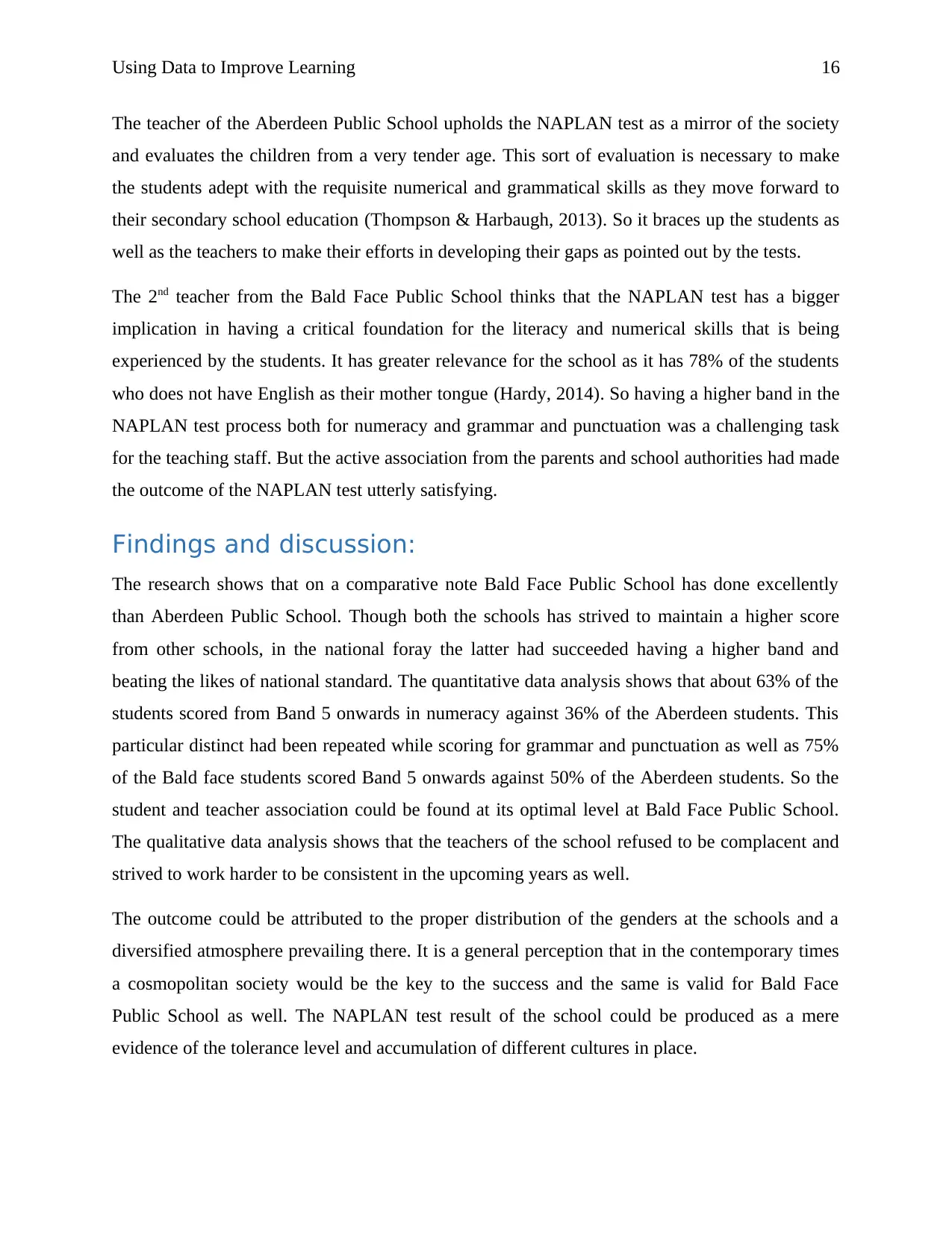
Using Data to Improve Learning 16
The teacher of the Aberdeen Public School upholds the NAPLAN test as a mirror of the society
and evaluates the children from a very tender age. This sort of evaluation is necessary to make
the students adept with the requisite numerical and grammatical skills as they move forward to
their secondary school education (Thompson & Harbaugh, 2013). So it braces up the students as
well as the teachers to make their efforts in developing their gaps as pointed out by the tests.
The 2nd teacher from the Bald Face Public School thinks that the NAPLAN test has a bigger
implication in having a critical foundation for the literacy and numerical skills that is being
experienced by the students. It has greater relevance for the school as it has 78% of the students
who does not have English as their mother tongue (Hardy, 2014). So having a higher band in the
NAPLAN test process both for numeracy and grammar and punctuation was a challenging task
for the teaching staff. But the active association from the parents and school authorities had made
the outcome of the NAPLAN test utterly satisfying.
Findings and discussion:
The research shows that on a comparative note Bald Face Public School has done excellently
than Aberdeen Public School. Though both the schools has strived to maintain a higher score
from other schools, in the national foray the latter had succeeded having a higher band and
beating the likes of national standard. The quantitative data analysis shows that about 63% of the
students scored from Band 5 onwards in numeracy against 36% of the Aberdeen students. This
particular distinct had been repeated while scoring for grammar and punctuation as well as 75%
of the Bald face students scored Band 5 onwards against 50% of the Aberdeen students. So the
student and teacher association could be found at its optimal level at Bald Face Public School.
The qualitative data analysis shows that the teachers of the school refused to be complacent and
strived to work harder to be consistent in the upcoming years as well.
The outcome could be attributed to the proper distribution of the genders at the schools and a
diversified atmosphere prevailing there. It is a general perception that in the contemporary times
a cosmopolitan society would be the key to the success and the same is valid for Bald Face
Public School as well. The NAPLAN test result of the school could be produced as a mere
evidence of the tolerance level and accumulation of different cultures in place.
The teacher of the Aberdeen Public School upholds the NAPLAN test as a mirror of the society
and evaluates the children from a very tender age. This sort of evaluation is necessary to make
the students adept with the requisite numerical and grammatical skills as they move forward to
their secondary school education (Thompson & Harbaugh, 2013). So it braces up the students as
well as the teachers to make their efforts in developing their gaps as pointed out by the tests.
The 2nd teacher from the Bald Face Public School thinks that the NAPLAN test has a bigger
implication in having a critical foundation for the literacy and numerical skills that is being
experienced by the students. It has greater relevance for the school as it has 78% of the students
who does not have English as their mother tongue (Hardy, 2014). So having a higher band in the
NAPLAN test process both for numeracy and grammar and punctuation was a challenging task
for the teaching staff. But the active association from the parents and school authorities had made
the outcome of the NAPLAN test utterly satisfying.
Findings and discussion:
The research shows that on a comparative note Bald Face Public School has done excellently
than Aberdeen Public School. Though both the schools has strived to maintain a higher score
from other schools, in the national foray the latter had succeeded having a higher band and
beating the likes of national standard. The quantitative data analysis shows that about 63% of the
students scored from Band 5 onwards in numeracy against 36% of the Aberdeen students. This
particular distinct had been repeated while scoring for grammar and punctuation as well as 75%
of the Bald face students scored Band 5 onwards against 50% of the Aberdeen students. So the
student and teacher association could be found at its optimal level at Bald Face Public School.
The qualitative data analysis shows that the teachers of the school refused to be complacent and
strived to work harder to be consistent in the upcoming years as well.
The outcome could be attributed to the proper distribution of the genders at the schools and a
diversified atmosphere prevailing there. It is a general perception that in the contemporary times
a cosmopolitan society would be the key to the success and the same is valid for Bald Face
Public School as well. The NAPLAN test result of the school could be produced as a mere
evidence of the tolerance level and accumulation of different cultures in place.
Secure Best Marks with AI Grader
Need help grading? Try our AI Grader for instant feedback on your assignments.
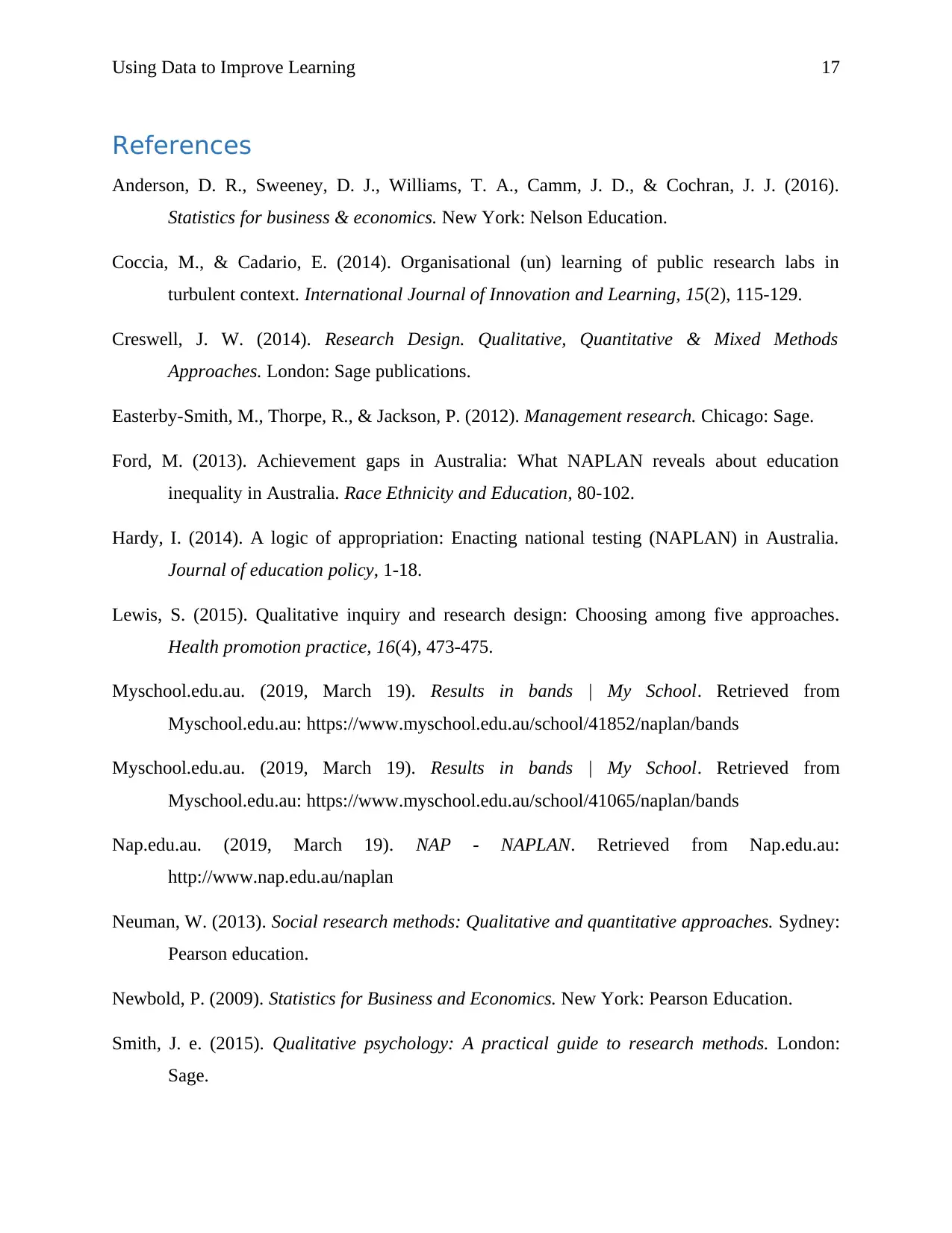
Using Data to Improve Learning 17
References
Anderson, D. R., Sweeney, D. J., Williams, T. A., Camm, J. D., & Cochran, J. J. (2016).
Statistics for business & economics. New York: Nelson Education.
Coccia, M., & Cadario, E. (2014). Organisational (un) learning of public research labs in
turbulent context. International Journal of Innovation and Learning, 15(2), 115-129.
Creswell, J. W. (2014). Research Design. Qualitative, Quantitative & Mixed Methods
Approaches. London: Sage publications.
Easterby-Smith, M., Thorpe, R., & Jackson, P. (2012). Management research. Chicago: Sage.
Ford, M. (2013). Achievement gaps in Australia: What NAPLAN reveals about education
inequality in Australia. Race Ethnicity and Education, 80-102.
Hardy, I. (2014). A logic of appropriation: Enacting national testing (NAPLAN) in Australia.
Journal of education policy, 1-18.
Lewis, S. (2015). Qualitative inquiry and research design: Choosing among five approaches.
Health promotion practice, 16(4), 473-475.
Myschool.edu.au. (2019, March 19). Results in bands | My School. Retrieved from
Myschool.edu.au: https://www.myschool.edu.au/school/41852/naplan/bands
Myschool.edu.au. (2019, March 19). Results in bands | My School. Retrieved from
Myschool.edu.au: https://www.myschool.edu.au/school/41065/naplan/bands
Nap.edu.au. (2019, March 19). NAP - NAPLAN. Retrieved from Nap.edu.au:
http://www.nap.edu.au/naplan
Neuman, W. (2013). Social research methods: Qualitative and quantitative approaches. Sydney:
Pearson education.
Newbold, P. (2009). Statistics for Business and Economics. New York: Pearson Education.
Smith, J. e. (2015). Qualitative psychology: A practical guide to research methods. London:
Sage.
References
Anderson, D. R., Sweeney, D. J., Williams, T. A., Camm, J. D., & Cochran, J. J. (2016).
Statistics for business & economics. New York: Nelson Education.
Coccia, M., & Cadario, E. (2014). Organisational (un) learning of public research labs in
turbulent context. International Journal of Innovation and Learning, 15(2), 115-129.
Creswell, J. W. (2014). Research Design. Qualitative, Quantitative & Mixed Methods
Approaches. London: Sage publications.
Easterby-Smith, M., Thorpe, R., & Jackson, P. (2012). Management research. Chicago: Sage.
Ford, M. (2013). Achievement gaps in Australia: What NAPLAN reveals about education
inequality in Australia. Race Ethnicity and Education, 80-102.
Hardy, I. (2014). A logic of appropriation: Enacting national testing (NAPLAN) in Australia.
Journal of education policy, 1-18.
Lewis, S. (2015). Qualitative inquiry and research design: Choosing among five approaches.
Health promotion practice, 16(4), 473-475.
Myschool.edu.au. (2019, March 19). Results in bands | My School. Retrieved from
Myschool.edu.au: https://www.myschool.edu.au/school/41852/naplan/bands
Myschool.edu.au. (2019, March 19). Results in bands | My School. Retrieved from
Myschool.edu.au: https://www.myschool.edu.au/school/41065/naplan/bands
Nap.edu.au. (2019, March 19). NAP - NAPLAN. Retrieved from Nap.edu.au:
http://www.nap.edu.au/naplan
Neuman, W. (2013). Social research methods: Qualitative and quantitative approaches. Sydney:
Pearson education.
Newbold, P. (2009). Statistics for Business and Economics. New York: Pearson Education.
Smith, J. e. (2015). Qualitative psychology: A practical guide to research methods. London:
Sage.
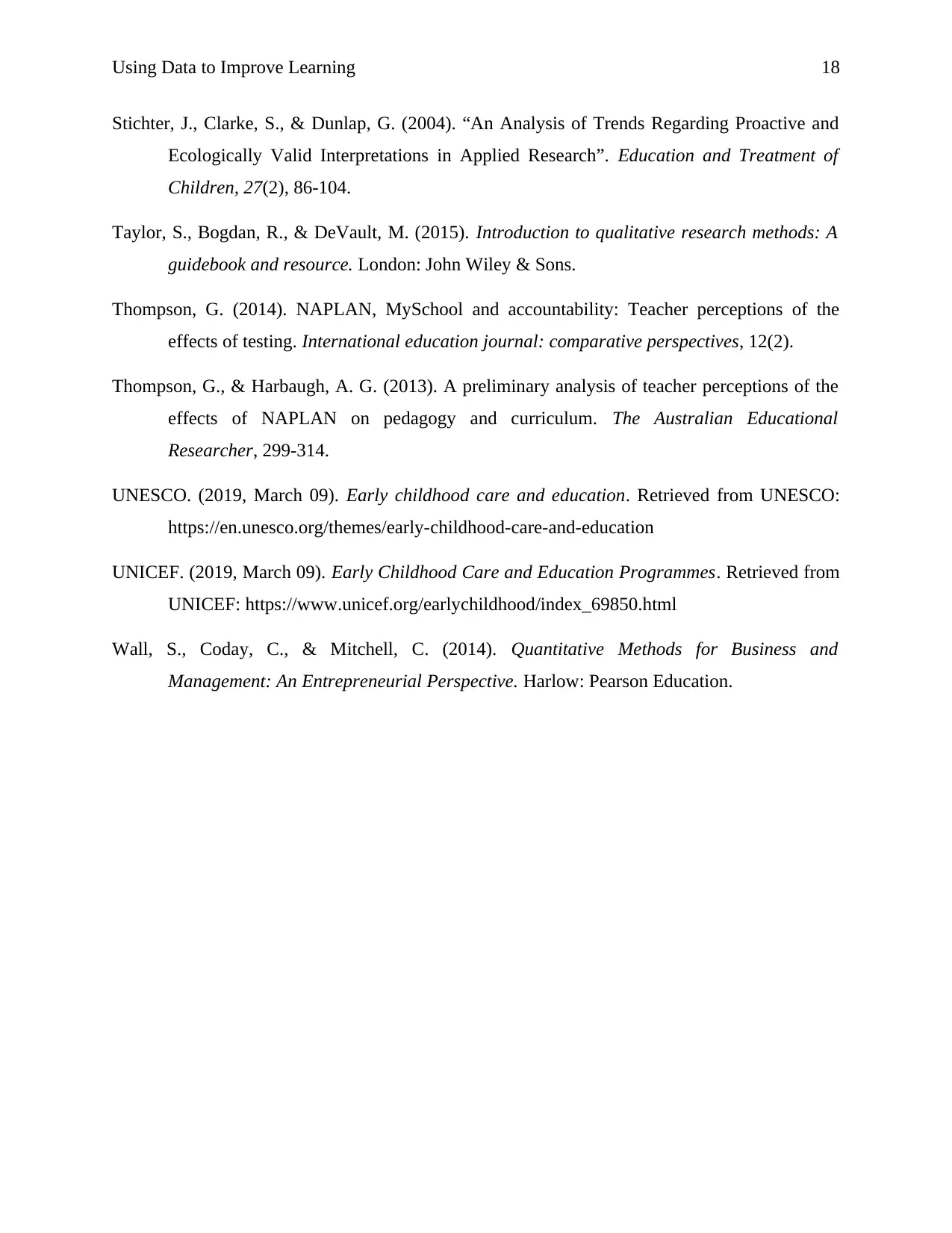
Using Data to Improve Learning 18
Stichter, J., Clarke, S., & Dunlap, G. (2004). “An Analysis of Trends Regarding Proactive and
Ecologically Valid Interpretations in Applied Research”. Education and Treatment of
Children, 27(2), 86-104.
Taylor, S., Bogdan, R., & DeVault, M. (2015). Introduction to qualitative research methods: A
guidebook and resource. London: John Wiley & Sons.
Thompson, G. (2014). NAPLAN, MySchool and accountability: Teacher perceptions of the
effects of testing. International education journal: comparative perspectives, 12(2).
Thompson, G., & Harbaugh, A. G. (2013). A preliminary analysis of teacher perceptions of the
effects of NAPLAN on pedagogy and curriculum. The Australian Educational
Researcher, 299-314.
UNESCO. (2019, March 09). Early childhood care and education. Retrieved from UNESCO:
https://en.unesco.org/themes/early-childhood-care-and-education
UNICEF. (2019, March 09). Early Childhood Care and Education Programmes. Retrieved from
UNICEF: https://www.unicef.org/earlychildhood/index_69850.html
Wall, S., Coday, C., & Mitchell, C. (2014). Quantitative Methods for Business and
Management: An Entrepreneurial Perspective. Harlow: Pearson Education.
Stichter, J., Clarke, S., & Dunlap, G. (2004). “An Analysis of Trends Regarding Proactive and
Ecologically Valid Interpretations in Applied Research”. Education and Treatment of
Children, 27(2), 86-104.
Taylor, S., Bogdan, R., & DeVault, M. (2015). Introduction to qualitative research methods: A
guidebook and resource. London: John Wiley & Sons.
Thompson, G. (2014). NAPLAN, MySchool and accountability: Teacher perceptions of the
effects of testing. International education journal: comparative perspectives, 12(2).
Thompson, G., & Harbaugh, A. G. (2013). A preliminary analysis of teacher perceptions of the
effects of NAPLAN on pedagogy and curriculum. The Australian Educational
Researcher, 299-314.
UNESCO. (2019, March 09). Early childhood care and education. Retrieved from UNESCO:
https://en.unesco.org/themes/early-childhood-care-and-education
UNICEF. (2019, March 09). Early Childhood Care and Education Programmes. Retrieved from
UNICEF: https://www.unicef.org/earlychildhood/index_69850.html
Wall, S., Coday, C., & Mitchell, C. (2014). Quantitative Methods for Business and
Management: An Entrepreneurial Perspective. Harlow: Pearson Education.
1 out of 18
Related Documents
Your All-in-One AI-Powered Toolkit for Academic Success.
+13062052269
info@desklib.com
Available 24*7 on WhatsApp / Email
![[object Object]](/_next/static/media/star-bottom.7253800d.svg)
Unlock your academic potential
© 2024 | Zucol Services PVT LTD | All rights reserved.





